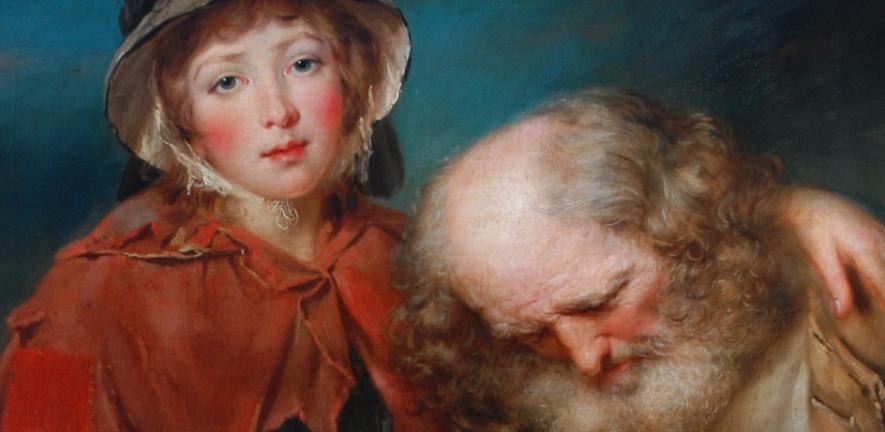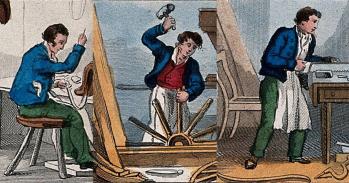
A Cambridge academic’s research into the final days of the Old English Poor Law has thrown up some remarkable parallels to today’s welfare state – and casts new light on the ‘benefits system’ of the eighteenth and nineteenth centuries.
A Cambridge academic’s research into the final days of the Old English Poor Law has thrown up some remarkable parallels to today’s welfare state – and casts new light on the ‘benefits system’ of the eighteenth and nineteenth centuries.
Payments were nearly always to the elderly and single mothers.
Samantha Williams
Dr Samantha Williams has examined the plight of the poor and their families in two Bedfordshire communities between 1760 and the Poor Law Amendment Act of 1834 in her recently-published book Poverty, Gender and Life-Cycle under the English Poor Law.
Challenging commonly-held beliefs that the poor of centuries past were left to flounder, often in crushing poverty, Dr Williams’ work reveals a generous system of welfare existed in parts of England – with lone mothers and the elderly by far the largest recipients. While a few paupers were accommodated in the workhouse, most received welfare assistance while they continued to live in their own homes.
The system of relief could sometimes be remarkably charitable to those in the direst need. Payments were worked out according to the earnings of neighbouring families with similar financial commitments. In some cases, Dr Williams discovered payments could amount to more than 60 per cent of a normal household’s income.
Her work also questions the subscription of many modern historians to the views of the Revd. Thomas Malthus – a vocal and controversial opponent of welfare spending – who believed such relief accounted for rapid population growth.
However, Dr Williams’ research debunks the notion that vast amounts were being spent on couples with large families or unemployed men, as Malthus and others believed.
She spent four years poring over and cross-referencing 90,000 records about the inhabitants of Campton (a village) and Shefford (a market town) as research for her book. Campton, for example, saw a ten-fold increase in Poor Law spending during the 70-year period she researched.
Both places have a wealth of preserved documents relating to their inhabitants and welfare beneficiaries, as well as records pertaining to the magistracy, vestry and village ratepayers.
The records reveal that like today, only a tiny minority were lifetime recipients of benefits. Instead, 85 per cent were ‘life-cycle’ recipients of poor law relief; receiving payments during childhood, parenthood and old age with payments calculated depending on the numbers of children, sick, elderly or unemployed in any particular household.
Dr Williams said: “Payments were nearly always to the elderly and single mothers. Access to poor relief was heavily gendered with young widows and unmarried mothers accounting for four-fifths of lone parent recipients. Elderly women were more than twice as likely to be relieved as old men. We must realise, however, that the birth of illegitimate children to errant fathers was massively widespread during this period in history. In fact, there was an early form of the Child Support Agency, with local officials tracking down and jailing fathers who were not supporting their offspring.”
Dr Williams, a lecturer at Cambridge University’s Institute of Continuing Education, meticulously researched poverty and welfare provisions using poor law accounts and cross-referencing those with parish family records – the first time this has been done – to reveal an extraordinarily detailed picture of exactly who was getting Poor Law relief and why.
The local parish vestry were a committee of landowners, farmers and ratepayers who sat in judgement of applications for the payment of poor relief. They also appointed an ‘overseer’ to give out benefits, collect the poor rates and make decisions for emergency help.
After 1790, the Old Poor Law (Act of 1601) was in crisis. Poverty had worsened and the number of poor had escalated to unmanageable levels. The crisis, particularly evident in the South Midlands, South and South East, worsened due to factors such as harvest failures, rapid price inflation, a deficit of jobs as great numbers returned from the Revolutionary and Napoleonic Wars, population increase and the decline of traditional cottage industries such as hand-spinning and weaving.
Attitudes towards the poor hardened in the early nineteenth century and they were increasingly stigmatised and pauperised. The political climate shifted away from sympathy and compassion to looking upon the needy as idle, lazy and feckless, accusations which have continued to echo down the centuries and still inform current debate, both in Parliament and public life.
Calls for reform were finally heeded in 1834 with the passing of the Poor Law Amendment Act which sought to centralise relief, lessen eligibility and make provision for ‘deterrent workhouses’. Poor law spending in Bedfordshire halved and the ‘less eligibility’ principle meant that after 1880, around three per cent of the public got relief, while at least a further 25 per cent in poverty were left to survive without public assistance.
Added Dr Williams: “Before 1834 the elderly and lone parents received generous weekly ‘pensions’ (‘pensions’ at that time did not relate solely to the elderly). The elderly could get payments up to 62 per cent of neighbouring labouring households’ income, while lone parents – families headed by a widow, unmarried mother or deserted wife – could receive up to 37 per cent. Extras such as fuel, clothing and rent payments contributed another 8 per cent, and so some pensioners were given up to 70 per cent.
“However, contrary to popular belief at the time – espoused by the likes of Revd Thomas Malthus and the architects of the Poor Law Amendment Act – my research has shown that couple-headed families were not well supported at all. That is also in marked contrast to the many economic historians who assumed there was a marked shift in relief to male heads of households between 1795 and 1834.”
This work is licensed under a Creative Commons Licence. If you use this content on your site please link back to this page.





